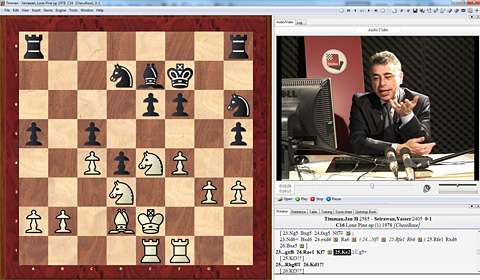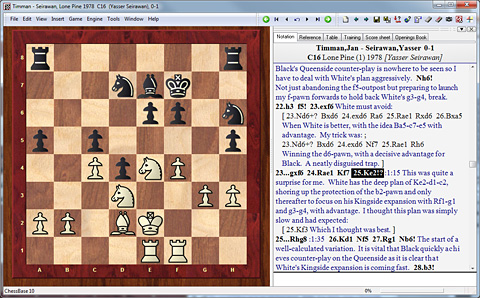


Review by Albert Silver
Back in the 80s, I was an avid subscriber to Seirawan's magazine, Inside Chess. Every two weeks, I eagerly awaited the tournament reports, interesting articles, and above all, detailed comments to games in his singularly engaging style. When I received the new ChessBase DVD, My Best Games by Seirawan, I obviously looked forward to it, and wondered how it would translate to the multimedia technology.
As a rule, I'm a big fan of the multimedia DVDs, though it must be said that the results aren't all of equal quality. Much like game collections in books, some authors just aren't as compelling in their presentation or notes. If you've never bought one of these DVDs, I'd like to quickly share what differs so much as opposed to books, apart from the obvious.
Aspiring chess players are usually given a number of general and standard recommendations, such as studying tactics and mates, analyzing ones own games, and play through the games collections of great players annotated by them. The best games collections are the ones that help you understand how a strong player thinks, almost giving you the impression that their thought processes, despite the absurd Elo difference (for most of us), is within our reach. The first games collection I owned and read was by the ineffable Bobby Fischer. It was both an exhilarating and frustrating experience. Bobby was out for his chess truth, which meant tons and tons of analysis. The games were mystical and fascinating, but replaying them I constantly got lost, and had to backtrack. It was not fun.
That is one point where the DVD collections really take the experience to a whole new level. To begin with, the games are a simple click and watch. The usual chessboard appears, with the expected chess notation, but there is also the video screen showing the grandmaster speaking and presenting his games. He will play through the lines, and back, always speaking to you as if you were his sole audience, making it both personal and intimate. You can treat the collection as a TV series (I can already hear the purists screaming 'sacrilege'), where you just load up a game, sit back, and watch it for the 10-25 minutes it may last, enjoying the experience.

Seirawan explains his opponent's (Timman's) plan and the problem he perceived in it.
Watching the player is a big part of what makes it special and unique, far beyond what any text alone could provide. Reading a player tell you how excited he was is one thing, but watching Kortchnoi get all worked up explaining how much he wanted to win, seeming like he is about to jump out of his seat, or seeing Short's voice and body language tighten up the minute he begins presenting his game against Kasparov, against whom he suffered so many times over the board... Just magic.
Each game is presented with a light introduction lasting anywhere from one to three minutes, presenting the circumstances of the game, as well as background stories. The actual game presentations are strongly focused around the ideas and plans in the games, with some essential variations, but fewer than in other collections. Some stronger players might be put off by this, feeling this makes it superficial, but this angle is a deliberate choice. As will be seen, Seirawan is a positional player who is extremely conceptual, and no amount of variations could explain his maneuver in the following position.

Fantastic maneuver by Seirawan in the 1979 World Junior Ch.
His presentation, not only of these type of plans, but how he conceived them and the rationale behind them, is very instructional. Yasser explains more than once that his goal in the video presentations is to cover the turning points, and the main ideas of the game. To "give the game's flavor" as he adds. He also points out that for those who want to work through the detailed lines, one can click on the annotated game (without the video), and access the full notes, with Fritz to cover any unanswered questions he may have left.

In the text annotations, one can see added interesting material such as the time
spent by each player.
The journey from expert to grandmaster and beyond is quite fascinating, and covers the first 16 of the full 22 games. The first game is his win as an expert in 1975 against GM Bisguier in the US Open, and then proceeds to his first international master norm, his victory at the World Junior Championship, and his quest for the grandmaster title, crowned by a fantastic tournament win at the 1980 edition of Wijk an Zee where he won his third norm, capped by a 2700 Elo performance (using 1980 Elos by the way).
During this trek, the viewer is treated to innumerous comments regarding his perspective on chess, such as the emphasis on chess as a battle of ideas, implementing one's own plans, as well as preventing those of others. He obviously didn't coin these concepts, but his exposition via his games and how he uses them to guide his moves and plans, goes a long way in illustrating their application. He shares his views on openings, as well as essential differences in the way an attacking player and a defensive player may evaluate positional characteristics.
Interestingly, in spite of the explicit comments on his view of the battle on the board, Seirawan also indirectly underlines the enormous importance of growing self-belief that helped impel him to continue seeking to develop and reach the next level. After some of the games, he shares the gradual confidence boosters that gave him the belief to become what he did. After beating Timman for the first time in a tournament where he scored an IM norm, he comments that after the game he reasoned that if he could beat a top player, rated 2585 then, then he had potential too. This comment also shows that there was nothing self-evident about it, and he shared the same self-doubts we all do. Again, after beating John Grefe, a US champion, he concluded, "If I can beat a US champion, why can't I become one myself?"
As a video commentator, Yasser Seirawan's style and voice are extremely accessible to foreign viewers. This isn't always true of other authors, whose accents can be difficult to understand for non-fluent people. He speaks calmly and has excellent enunciation, but of course, even if you do miss something, you can just play it back.
Overall, I must say I thoroughly enjoyed the DVD, as is no doubt apparent, and can recommend it unreservedly. The games are enjoyable and well-presented, played against notable players such as Larsen, Tal, Kortchnoi, and Karpov, to name a few, and span 5 hours in all.